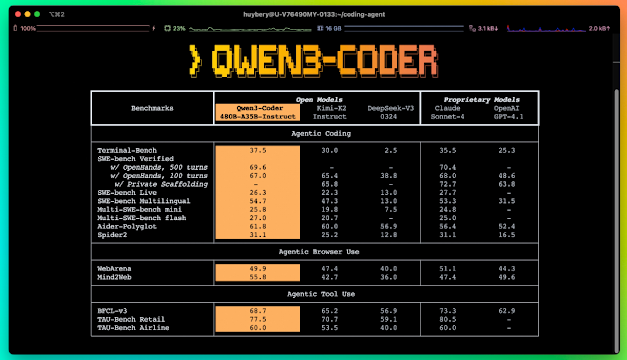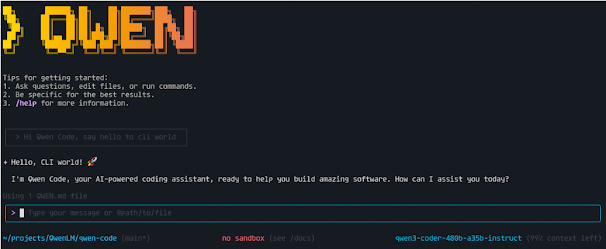Introduction
The world of Agentic Coding is transforming rapidly from basic code completion to sophisticated AI agents that understand entire codebases and can autonomously complete complex software engineering tasks. This paradigm aims to change how developers measure productivity, but the concepts have not yet translated to using larger context and multi-step reasoning. Qwen3-Coder understands this dilemma, and is poised to tackle it head-on. Unlike a supportive co-pilot, Qwen3-Coder is, paradoxically, an independent enforcement agent on the cutting edge of the recognition of code and tooling integrations on the pathway to a future of more productive, higher quality software design.
Development and Contributors
Qwen3-Coder is the flagship agentic model developed by the Qwen team, from an effort to create an AI as an excellent Software architect. The goal was not to have simply a better assistant, but to bring a fundamental transformation in how developers leverage AI to manage and execute complex projects.
What is Qwen3-Coder?
Qwen3-Coder is an incredibly sophisticated, open-source AI model for agentic software development. It is meant to act as an advanced AI agent that can autonomously parse, plan, and execute complex coding projects by effectively comprehending the full context of a software project.
Key Features of Qwen3-Coder
Qwen3-Coder is full of an arsenal of distinct features that make it diverge from its ancestors and contemporaries:
- Effective Mixture-of-Experts (MoE) Architecture: Employs a enormous 480B-parameter MoE architecture that only uses 35B parameters for each query while balancing enormous capability with computational effectiveness.
- Massive Long-Context Window: Natively supports a 256K token window, extendable to 1M tokens, providing a deep, repository-wide code understanding.
- Streamlined Non-thinking Mode: Outputs straight, clean output without overt reasoning blocks so it can be used directly within automated scripts and toolchains.
- Specialized Tooling & Open Integration: Augmented by the Qwen Code CLI and open to the OpenAI SDK, providing both a specialized feel and wide compatibility with community tools.
Capabilities/Uses of Qwen3-Coder
The unique characteristics of Qwen3-Coder translate into a variety of compelling capabilities and practical uses in real life that may change the way you develop software:
- Self-Driving Large-Scale Codebase Optimization and Refactoring: Imagine needing to migrate a large project into a new framework. Qwen3-Coder is capable of self-planning and self-execution of such complex, large-scale, refactoring tasks across an entire codebase - improving performance and providing smarter edits across 1,000's of interrelated files.
- Smart Software Bug Repair and Vulnerability Repair: The model can perform sophisticated self-service debugging. It can identify, understand and repair complex bugs or security vulnerabilities that require deep contextual understanding and an iterative approach to resolving problems in an entire system.
- Automated Pull Requests and Sophisticated Rebase Management: Qwen3-Coder is able to offer a large amount of overhead to the developer by automating run operations. It can also autonomously review, resolve conflicts, and merge even very complex or large pull requests.
- Fast and Autonomous Prototype and Feature Prototyping: The system can create functioning code for new features or proof-of-concept applications with little human effort. For example, it has shown the capability to rapidly create simple SaaS landing pages with animations.
- Improved Code Documentation and Complete Test Suite Generation: Qwen3-Coder is able to automate the frequently time-consuming process of documentation and testing for large codebases. This involves producing complete, precise documentation and coming up with strong, context-sensitive test suites that handle inferred edge cases.
How Does Qwen3-Coder Work
From an engineering perspective, Qwen3-Coder's strength is derived from a highly optimized architecture and disciplined training schedule. Its base is a Mixture-of-Experts (MoE) model, a deliberate decision that permits enormous parameter scale (480B) while being computationally practical by only engaging a portion of experts (35B) for each input. The model's remarkable competence was nurtured by pre-training on an enormous 7.5 trillion token dataset with a high 70% code ratio. Of paramount importance, the quality of training data was progressively developed through iteratively using its predecessor, Qwen2.5-Coder, to reword and clean noisy data—a high-level feedback loop that reflects a focus on data-driven AI development. That foundation is also supported by state-of-the-art reinforcement learning. The model makes use of scaled Code RL on 'hard-to-solve, easy-to-verify' problems as well as a new Long-Horizon RL (Agent RL) to learn challenging, multi-step engineering tasks. This agentic finetuning is underpinned by an enormous parallel system operating 20,000 independent environments, allowing the model to learn from a huge and varied array of feedback signals and thereby sharpening its autonomous problem-solving abilities.
Performance Evaluation with Other Models
When assessed on benchmarks, Qwen3-Coder is uniquely situated in performance among the best models, both open source and proprietary. For examples of performance in the real world, with limited tuning, simply compare SWE-Bench Verified. For an open model, Qwen3-Coder achieved state-of-the-art performance without any test-time scaling - an important distinction to note, focusing on performance out-of-the-box, and for agentic coding, tool-use, and processing of feedback, this is a powerful metric in performance, and contribution to the quality of results of a specific task completion.
SWE-Bench Verified is a particularly impressive benchmark that measures the outcomes of solving real software engineering (SE) evaluation tasks with multi-turn planning, tooling use, and processing feedback. Not only are its scores strong by themselves, they are directly competitive to (and often surpass) results achieved by existing proprietary models, such as Claude Sonnet 4 and GPT-4.1, obtained via reference evaluations (e.g., Spider, Aider). For any developer or teams considering accessing an AI coding agent, the results speak volumes - Qwen3-Coder is neither simply an alternative to an open-source coding agent - it is seriously challenging the highest tier agentic coding, tool-use and browser-use performance, and this should not be overlooked.
Key differentiators with Kimi K2
While Qwen3-Coder shares some commonalities with other powerful models like Kimi K2, there are several relevant differences in design that provide Qwen3-Coder with much greater capabilities. For example, Qwen3-Coder's native 256K and extended 1M token window exceed Kimi K2's context length of 128K context length in a major way, meaning that Qwen3-Coder will outperform Kimi K2 across any extended codebase. To put that in perspective, even if Kimi K2 were to run a context length of 128K on longer codebases, this would still be able to be further improve from other aspects such as task formulation to general alignment to tools towards its reasoning capabilities over and above just to get beyond the black box. A second key distinction is the actual internal data improvement loop that Qwen3-Coder ran on Qwen2, leveraging its predecessor to improve its training data, a significant mechanism for improving the quality of its data. From a practical development experience, Qwen3-Coder's non-thinking smoothness factor, and open model connected experience with tools offered by OpenAI SDK and specially designed Qwen Code CLI allows for usability experience that demonstrates functionality beyond Kimi K2's focus on multi-tool orchestration and passive thinking alone.
How to Access and Use Qwen3-Coder
Developers can easily access Qwen3-Coder and responsibly integrate it with systems and application development. Being an open-source and commercially usable model means the model weights are downloadable for local use. Installation instructions can be found on the official GitHub repository of Qwen3-Coder which centralizes everything. The easiest and fastest workflow to access for most integration is to utilize its support for the OpenAI SDK. This is a typical standard so the barrier to entry is low, i.e. some familiarity with the coding language used to develop your application.
To fully realize the possibilities for agentic potential, you will want to use the Qwen Code CLI. Which is an open-sourced command-line interface at this stage that uses Node.js (v20+) and is built specifically for the model. This CLI has a built parser and function-calling form that optimally works with the code model. The benefit of using its CLI is to have a more defined and specialized workflow process for multi-level logical coding tasks.
Limitations and Future Work
Though Qwen3-Coder is an impressive tool, some practical considerations should be noted for developers. Being a new tech, the supporting Qwen Code CLI might have temporary stability problems. Hardware-wise, though long-context functionality is a flagship feature, some configurations might face out-of-memory situations, which would require lowering the context length for smoother functionality. In addition, within the aggressively competitive market of agentic models, benchmarks indicate that on certain tasks like SWE-bench Verified, competition from the likes of Kimi K2-Instruct already maintains an edge in performance, pointing out points for ongoing improvement.
The Qwen team has a great ambition for the future. First, the plan is to continue to enhance the Coding Agent's performance to help take on more software engineering tasks that are even longer and more cumbersome, allowing developers to achieve even more productivity! Then, the Qwen team will release additional model sizes that will strike even more of a balance between proper performance and cost-effective deployment. However, the most exciting long term vision is starting to explore self-improvement abilities of the agent. The idea of creating a tool that is evolving and able to learn and perform multiple tasks, including more complicated tasks, on its own demonstrates the beginnings of a truly exciting future for the evolution of agentic AI.
Conclusion
Qwen3-Coder is a watershed moment. It is (an open-source) software that provides access to state-of-the-art agentic AI to developers and organizations to build better software more quickly. The coding of tomorrow is not just coding lines, but the creation of intelligent systems, and Qwen3-Coder is one of the brightest future's architects.
Source:
Blog: https://qwenlm.github.io/blog/qwen3-coder/
Qwen Code CLI: https://github.com/QwenLM/qwen-code
GitHub Repo: https://github.com/QwenLM/Qwen3-Coder
Model Weights: https://huggingface.co/collections/Qwen/qwen3-coder-687fc861e53c939e52d52d10
Disclaimer - This article is intended purely for informational purposes. It is not sponsored or endorsed by any company or organization, nor does it serve as an advertisement or promotion for any product or service. All information presented is based on publicly available resources and is subject to change. Readers are encouraged to conduct their own research and due diligence.



No comments:
Post a Comment